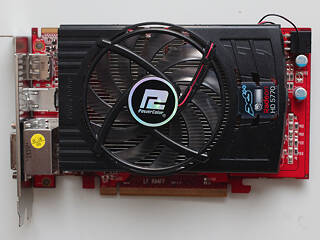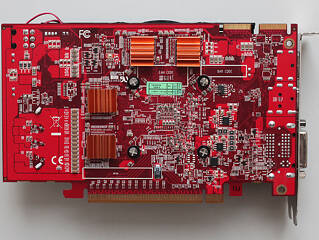 7
7
PowerColor HD 5770 PCS++ 1 GB Review
A Closer Look »The Card
The PCB is as compact as all other HD 5770 PCBs. The most noteworthy feature here is the use of little heatsinks on the memory.
Due to the cooler design PowerColor installed the memory heatsinks only on one side of the PCB. The memory chips on the other side sit in the cooler's airflow, so they receive direct cooling.
The card occupies two slots in your system.
The card has two DVI ports, one HDMI port, and one DisplayPort. This is just one of many output configurations that are possible on the new cards, thanks to the overhauled display output logic. Basically the card can drive six TMDS signals that can be combined in any way (a dual-link DVI consumes two TMDS lines).
For HDMI Audio, NVIDIA requires you to feed an external audio source, for example from your motherboard's on-board audio, to the card via SPDIF cable. AMD on the other hand has integrated a sound device inside their GPUs which is the easier solution for most users. Also AMD's integrated sound device has been upgraded to support HDMI 1.3a which includes Dolby TrueHD, DTS-HD, AC-3, DTS and up to 7.1 channel audio with 192 kHz / 24-bit.
CrossFire configurations with up to four cards are supported, you may also mix cards from different vendors in your CrossFire setup.
Here are the front and the back of the card, high-res versions are also available (front, back). If you choose to use these images for voltmods etc, please include a link back to this site or let us post your article.
Jul 2nd, 2025 23:27 CDT
change timezone
Latest GPU Drivers
New Forum Posts
- NVIDIA App (36)
- Will you buy a RTX 5090? (588)
- AMD RX 7000 series GPU Owners' Club (1327)
- What's your latest tech purchase? (24189)
- RDNA 4 Fine Wine? (HUB Vid) (41)
- GravityMark v1.89 GPU Benchmark (308)
- Good time in the year to buy a new PC (5)
- The Official Thermal Interface Material thread (1767)
- What Windows is overall the best to you and why? (262)
- Nvidia drivers (6)
Popular Reviews
- ASUS ROG Crosshair X870E Extreme Review
- Crucial T710 2 TB Review - Record-Breaking Gen 5
- Sapphire Radeon RX 9060 XT Pulse OC 16 GB Review - An Excellent Choice
- PowerColor ALPHYN AM10 Review
- Upcoming Hardware Launches 2025 (Updated May 2025)
- AMD Ryzen 7 9800X3D Review - The Best Gaming Processor
- AVerMedia CamStream 4K Review
- Sapphire Radeon RX 9070 XT Nitro+ Review - Beating NVIDIA
- NVIDIA GeForce RTX 5060 8 GB Review
- AMD Ryzen 9 9950X3D Review - Great for Gaming and Productivity
TPU on YouTube
Controversial News Posts
- Intel's Core Ultra 7 265K and 265KF CPUs Dip Below $250 (288)
- NVIDIA Grabs Market Share, AMD Loses Ground, and Intel Disappears in Latest dGPU Update (212)
- Some Intel Nova Lake CPUs Rumored to Challenge AMD's 3D V-Cache in Desktop Gaming (140)
- NVIDIA GeForce RTX 5080 SUPER Could Feature 24 GB Memory, Increased Power Limits (114)
- NVIDIA Launches GeForce RTX 5050 for Desktops and Laptops, Starts at $249 (105)
- Microsoft Partners with AMD for Next-gen Xbox Hardware (105)
- Intel "Nova Lake‑S" Series: Seven SKUs, Up to 52 Cores and 150 W TDP (100)
- NVIDIA DLSS Transformer Cuts VRAM Usage by 20% (96)







